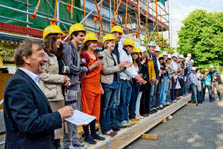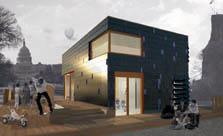

Team Germany members line up in front of the construction scaffolding surrounding their house.

The modernistic cube shape of the Team Germany house is covered with PV panels—crystalline silicon on the roof and thin-film copper indium diselenide on the sides.
Neither the United States, nor the Department of Energy, nor the Alliance for Sustainable Energy LLC, nor any of their contractors, subcontractors, or their employees make any warranty, express or implied, or assume any legal liability or responsibility for the accuracy, completeness, or usefulness for any purpose of any technical resources or data attached or otherwise presented here as reference material.
Solar Decathlon 2009
Team Germany
Technische Universität Darmstadt
Sustainability Is Skin Deep
Team Germany started with a "focus on the façade," creating a house that is essentially a two-story cube. The surface is covered with solar cells: an 11.1-kW photovoltaic (PV) system made of 40 single-crystal silicon panels on the roof and about 250 thin-film copper indium gallium diselenide (CIGS) panels on the sides that are expected to produce an incredible 200% of the energy needed by the house. The CIGS component is slightly less efficient than the silicon but will perform better in cloudy weather. The façade's highly insulating, custom vacuum insulation panels plus phase-change material in the drywall maintain comfortable temperatures. Automated louver-covered windows block unwanted solar heat.
The Team
The team is relatively small with only 24 students, mostly architects. But team member Sardika Meyer relates how many others took part. "Even my boyfriend, all the families and friends got involved," she says. "We had so much support; it was really incredible." Team Germany finished first in Solar Decathlon 2007, and the 2009 team has relied on members of the 2007 team for guidance.
The House
The Team Germany philosophy was to "push the envelope with as many new technologies as possible." In particular, the house was designed to maximize PV production and use of the net-metering connection to the electric utility grid on the National Mall. The result is a two-story, cube-shaped building with PV panels on the roof and sides and a single multifunctional living area on the inside. Described by the team as an aesthetic solar design, the house has a bed and other furniture and appliances that fold away or serve multiple purposes.
The Technology
The extensive PV panel deployment is the most notable feature of the Team Germany house, but other technologies include:
- Custom-made vacuum insulation structural panels
- Phase-change material in both walls (paraffin) and ceiling (salt hydrate)
- Automated louver-covered windows
- A boiler integrated into the heat pump system that allows the system to provide domestic hot water as well as heating and cooling.
House Highlights
- A two-story cube shape that provides maximum dimensions and surface area
- A surface area that is almost totally covered with PV panels—single-crystal silicon on the roof, thin-film copper indium gallium diselenide on the sides
- An expected production of twice the electricity needed
- A single multifunctional space inside
